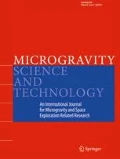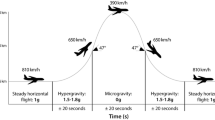Abstract
During the first days in space, i.e., after a transition from 1G to 0G, more than 50% of the astro- (and cosmonauts) suffer from the Space Adaptation Syndrome (SAS).The symptoms of SAS, like nausea and dizziness, are especially provoked by head movements. Astronauts have mentioned close similarities between the symptoms of SAS and the symptoms they experienced after a 1 hour centrifuge run on Earth, i.e., after a transition from 3G to 1G (denoted by Sickness Induced by Centrifugation, SIC). During several space missions, we related susceptibility to SAS and to SIC in 11 astronauts and found 4 of them being susceptible to both SIC and SAS, and 7 being not susceptible to SIC nor to SAS. This correspondence in susceptibility suggests that SIC and SAS share the same underlying mechanism. To further study this mechanism, several vestibular parameters have been investigated (e.g. postural stability, vestibularly driven eye movements, subjective vertical). We found some striking changes in individual cases that are possibly due to the centrifuge run. However, the variability between subjects generally is very large, making physiological links to SIC and SAS still hard to find.
Similar content being viewed by others
References
Homick, J L.: Space Motion Sickness. Acta Astronautica vol. 25, p. 1259–1272 (1979)
Matsnev, E I., Yakovlevka, I Y., Tarasov, I K., Alekseev, V N., Kornolova, L N., Mateev, A D., Gorniladze, G I.: Space Motion Sickness: Phenomenology, countermeasures, and mechanisms. Aviat. Space Environ. Med. vol 54, p. 312–317 (1983)
Oman,C M., Lichtenberg,B K., Money, K E., McCoy, R K.: M.I.T./Canadian vestibular experiments on the Spacelab-1 mission: 4. Space motion sickness: symptoms, stimuli, and predictability. Exp. Brain Res. vol. 64, p. 316–334 (1986)
Homick J L., Reschke M F., Vanderploeg J M., in Results of the Life Sciences DSO’s Conducted aboard the space shuttle, 1981-1986. Bungo M W., Bagian T M., Bowman, M A,, Levitan, B M. (Eds.) Houston, Texas, p. 153–158 (1987)
Ockels W J., Furrer R., Messerschmid E.: Simulation of space adaptation syndrome on earth. Exp. Brain Res. vol. 79, p. 661–663 (1990).
Groen, E L.: Orientation to gravity. PhD Thesis, (1997)
Irwin, J A.: The pathology of seasickness. The Lancet vol. 2, p. 907–909 (1881)
James, W.: The sense of dizziness in deaf-mutes. Am. J. Otology vol. 4, p. 239–254 (1882)
Reason, J T., Brand, J J.: Motion sickness Academic Press, London, p. 83–101 (1975)
Rolnick, A., Lubow, R E.: Why is the driver rarely motion sick? The role of controllability in motion sickness. Ergonomics vol. 34, p. 867–879 (1991)
Stanney, K M., Hash, P.: Locus of user-initiated control in virtual environments: influences on cybersickness. Presence vol. 7, p. 447–459 (1998).
Bles, W., Bos, J E., De Graaf, B., Groen, E. L., Wertheim, A H.: Motion sickness: only one provocative conflict? Brain Res. Bull. vol. 47, p. 481–487 (1998).
Oman, C M.: A heuristic mathematical model for the dynamics of sensory conflict and motion sickness. Acta Otolaryngol. Suppl. 392, p. 1–44 (1982).
Bos, J E., Bles, W.: Modelling motion sickness and subjective vertical mismatch detailed for vertical motions. Brain Res. Bull. vol. 47, p. 537–542 (1998)
Bos, J E., Bles, W.: Theoretical considerations on canal-otolith interaction and an observer model. Biol. Cybernetics vol. 86, p. 191–207 (2002).
Mayne, R., in: H.H. Kornhuber (Ed), Handbook of sensory physiology. IV-2 Vestibular system, Springer Verlag, Berlin, p. 493–580 (1974)
Bles, W., De Graaf, B., Bos J E., Krol, J R.: A sustained hypergravity load as a tool to simulate space sickness. J. Gravit. Physiol. vol. 4, p. 1–4 (1997)
Bles, W., Van Raaij, J.: Pre- and postflight (D-1) postural control in tilting environments. Adv Oto-Rhino-Laryng. vol 42, p. 13–17 (1988)
Bockisch, C., Haslwanter, T.: Three-dimensional eye position during static roll and pitch in humans. Vision Res. vol. 21, p2127–2137 (2001)
Furman, J M., Schor, R H.: Orientation of Listing’s Plane during static tilt in young and older human subjects. Vision Res. vol. 43, p. 67–76 (2003)
Haslwanter, T.: Mathematics of three-dimensional eye rotations. Vision Res. vol. 35, p1727–1739 (1995)
De Graaf, B., De Roo, J.: Effects of long duration centrifugation on head movements and a psychomotor task. J. Vest. Res. vol. 6, p. 23–29 (1996)
Bles, W., De Graaf, B.: Postural consequences of long duration centrifugation. J. Vest. Res. vol 3, p. 87–95 (1993)
Clarke, A,: The collinearity between Listings’s plane and the vestibular system in mircogravity. Presented at the 15th IAA Humans in Space Symposium, Benefits of Human Presence in Space, Graz, Austria (2005)
Bos, J E., Bles, W., De Graaf, B.: Eye movements to yaw, pitch, and roll about vertical and horizontal axes: adaptation and motion sickness. Aviat. Space Environ. Med. vol 73, p. 436–444 (2002).
Golding, J F., Stott, J R R.: Effect of sickness severity on habituation to repeated motion challenges in aircrew referred for airsickness treatment. Aviat. Space Environ. Med. vol. 66, p. 625–630 (1995)
Author information
Authors and Affiliations
Corresponding author
Rights and permissions
About this article
Cite this article
Nooij, S.A.E., Bos, J.E., Groen, E.L. et al. Space sickness on earth. Microgravity Sci. Technol 19, 113–117 (2007). https://doi.org/10.1007/BF02919464
Issue Date:
DOI: https://doi.org/10.1007/BF02919464




